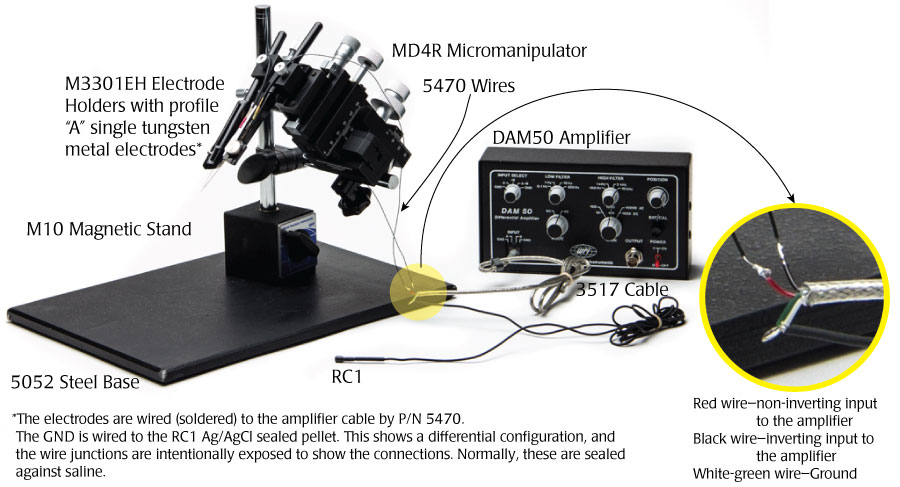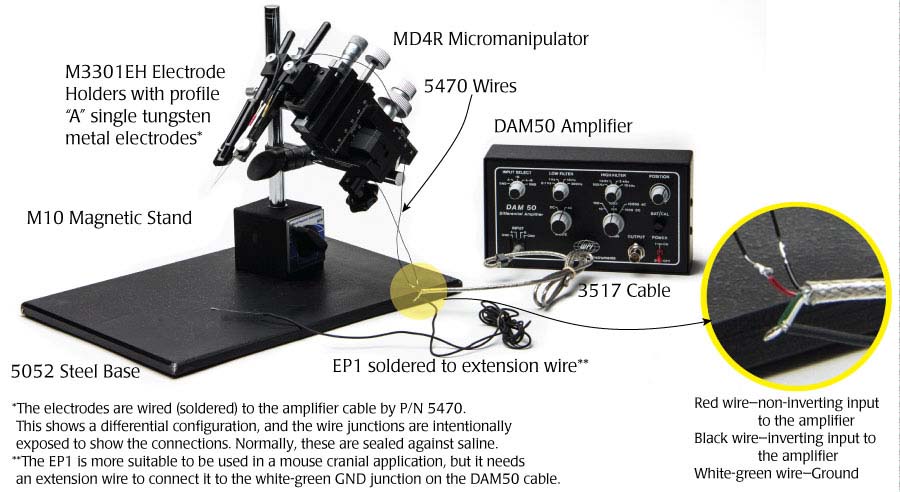
Using a DAM50 for EEG Recordings in Rodents
A low-noise amplifier like the DAM50 is an excellent choice for EEG recording in rodents. WPI's amplifiers were engineered for the bio-medical researcher. While 20-30μV of noise is common in bio-amplifiers, WPI’s DAM series amplifiers generate 0.4μV RMS (root mean squared) at 0.1-100Hz. (That’s equal to about 2μV peak to peak.) This setup shows one way such recordings could be made. The RC1 electrode works well for rats, and the EP1 is more suitable for mouse cranial application.
For this application, you will need the following equipment:
- (1) DAM50 amplifier
- (1) MD4R micromanipulator
- (2) M3301EH electrode holders
- (2) Profile A single tungsten metal electrodes
- (1) M10 stand
- (1) 5052 steel base plate
- (1) 5470 cable
- (1) electrode (RC1 or EP1)
Rat Cranial Applications
- The RC1 electrode comes with a 4' unterminated wire attached. That needs to be soldered to the green-white ground wire of the 5470 cable.
- The red wire from the 5470 cable connects with the non-inverting input on the amplifier, and the black wire connects with the inverting wire on the amplifier. Solder a Profile A tungsten electrodes to the red and black wires.
- For best results, seal the solder joints with a heat shrink tubing.
- Affix the Profile A electrodes in the M3301EH electrode holders as shown in the images below.
- Position the electrode holders into the two positions on the MD4R micromanipulator.
- Position the electrodes so that the tips of the electrodes are nearly touching. These electrodes can then be precisely positioned in a rodent's brain.
Mouse Cranial Application
The EP1 is a smaller electrode and is better suited for small rodents than the RC1 electrode. This application uses the same setup as the first one shown. In addition to the EP1 electrode, you will also need a length of wire to connect the green-white ground wire from the WPI #5470 cable with the EP1 electrode.
RC1
Reference Cell with 1.5 m lead. New, improved sintered pellets with lower resistance and high strength. Stable and well balanced in the presence of current, these small and inexpensive half-cells are easy to work with as bath electrodes.

M3301EH
Replacement Electrode Holder, 14 cm x 7.2 mm diameter.
Replacement Electrode f...













Request
Catalogue
Chat
Print